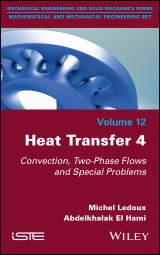Details

Heat Transfer 4
Convection, Two-Phase Flows and Special Problems1. Aufl.
|
126,99 € |
|
| Verlag: | Wiley |
| Format: | EPUB |
| Veröffentl.: | 09.12.2022 |
| ISBN/EAN: | 9781394186143 |
| Sprache: | englisch |
| Anzahl Seiten: | 192 |
DRM-geschütztes eBook, Sie benötigen z.B. Adobe Digital Editions und eine Adobe ID zum Lesen.
Beschreibungen
<p>Heat is a branch of thermodynamics that occupies a unique position due to its involvement in the field of practice. Being linked to the management, transport and exchange of energy in thermal form, it impacts all aspects of human life and activity.</p> <p>Heat transfers are, by nature, classified as conduction, convection (which inserts conduction into fluid mechanics) and radiation. The importance of these three transfer methods has resulted – justifiably – in a separate volume being afforded to each of them, with the subject of convection split into two volumes. This fourth volume is dedicated to convection, more specifically, the problem of particular convective transfers. Twophase convection is considered and a more recent and much lesser-known field is presented, that of phase change transfer. Particular significance is given to numerical applications, allowing the reader to handle orders of magnitude, an important point in all physics.</p> <p><i>Heat Transfer 4</i> combines a basic approach with a deeper understanding of the discipline and will therefore appeal to a wide audience, from technician to engineer, from doctoral student to teacher-researcher.</p>
<p>Preface ix</p> <p>Introduction xi</p> <p>List of Notations xix</p> <p><b>Chapter 1 Concepts of Gas–Liquid Flows 1</b></p> <p>1.1 Introduction and basic concepts 1</p> <p>1.2 Gas–liquid flows 2</p> <p>1.2.1 The physics of two-phase flows 3</p> <p>1.2.2 Classification of flows 16</p> <p>1.2.3 Topologies of a heated vertical flow 23</p> <p>1.2.4 Calculation of fluxes 27</p> <p>1.3 Dispersed phase flows: mists and sprays 35</p> <p>1.3.1 Mist 35</p> <p>1.3.2 Spray generation 37</p> <p>1.3.3 Spray characterization: particle sizing 38</p> <p>1.3.4 Spray vaporization: the case of the isolated drop 42</p> <p>1.4 Several examples 43</p> <p><b>Chapter 2 Convection of Species 63</b></p> <p>2.1 Introduction 63</p> <p>2.2 Characterization of a mixture: definitions 63</p> <p>2.3 Law of diffusive transfer: Fick’s law 64</p> <p>2.4 Similarity of transport equations 66</p> <p>2.5 Solving the equations of diffusive transport 69</p> <p>2.5.1 Analogies 69</p> <p>2.5.2 Non-reactive boundary layer: concentration fixed at the wall 71</p> <p>2.5.3 Non-reactive boundary layer: wall catalysis 73</p> <p>2.5.4 Reactive boundary layer 79</p> <p><b>Chapter 3 Phase Change Materials 81</b></p> <p>3.1 Introduction 81</p> <p>3.2 PCM for cooling mechatronics devices 84</p> <p>3.2.1 Description of heat transfer and PCM behavior 85</p> <p>3.2.2 PCM behavior 87</p> <p>3.3 Numerical model 88</p> <p>3.3.1 Description of the 3D model 88</p> <p>3.3.2 Heat sink without PCMs 90</p> <p>3.3.3 Heat sink with PCMs 91</p> <p>3.4 Conclusion 95</p> <p><b>Chapter 4 Electro-Thermo-Mechanical Modeling of Systems 97</b></p> <p>4.1 Introduction 97</p> <p>4.2 Theory of electro-thermo-mechanical coupling 98</p> <p>4.2.1 Electro-thermal phenomena 98</p> <p>4.2.2 Numerical formulation of the electro-thermo-mechanical coupling 100</p> <p>4.3 Finite element simulation of the electro-thermo-mechanical behavior 103</p> <p>4.3.1 Strong coupling of the electro-thermo-mechanical modeling 104</p> <p>4.3.2 Weak coupling of the electro-thermo-mechanical modeling 105</p> <p>4.4 Example of electro-thermo-mechanical simulation of an HBT transistor 105</p> <p>4.4.1 Global model of HPA 106</p> <p>4.4.2 Local model of an HBT transistor 110</p> <p>4.5 Modal analysis of mechatronic components 113</p> <p>4.5.1 Writing the equation of the vibration problem 113</p> <p>4.5.2 Variational formulation 115</p> <p>4.5.3 Finite element approximation 115</p> <p>4.5.4 Resolution in the frequency domain 117</p> <p>4.6 Stochastic modal analysis of mechatronics components 118</p> <p>4.7. Numerical identification of the elastic parameters of electronic components 119</p> <p>4.8 Example of modeling and simulation of the vibratory behavior of mechatronic components 120</p> <p>4.9 Conclusion 127</p> <p>Appendices 129</p> <p>Appendix 1 Physical Properties of Common Fluids 131</p> <p>Appendix 2 Physical Properties of Common Solids 133</p> <p>Appendix 3 Thermodynamic Properties of Water Vapor 137</p> <p>Appendix 4 Table of Functions: erf (x) erfc(x) and ierfc(x) 141</p> <p>References 143</p> <p>Index 151</p>
<p><b>Michel Ledoux</b> was Professor and Vice-President at the University of Rouen, France. He was also Director of the UMR CNRS CORIA, then Regional Delegate for Research and Technology in Upper Normandy, France. Specializing in fluid mechanics and transfers, he has worked in the fields of reactive boundary layers and spraying. Currently retired, he is an adviser to the Conservatoire National des Arts et Métiers in Normandy, collaborating with the Institute of Industrial Engineering Techniques (ITII) in Vernon, France.</p> <p><b>Abdelkhalak El Hami</b> is Full Professor of Universities at INSA-RouenNormandie, France. He is the author/co-author of several books and is responsible for several European pedagogical projects. He is a specialist in fluid structure interaction and problems of optimization and reliability in multi physical systems.</p>
Diese Produkte könnten Sie auch interessieren:

Turbulent Drag Reduction by Surfactant Additives

von: Feng-Chen Li, Bo Yu, Jin-Jia Wei, Yasuo Kawaguchi

156,99 €

Turbulent Drag Reduction by Surfactant Additives

von: Feng-Chen Li, Bo Yu, Jin-Jia Wei, Yasuo Kawaguchi

156,99 €














